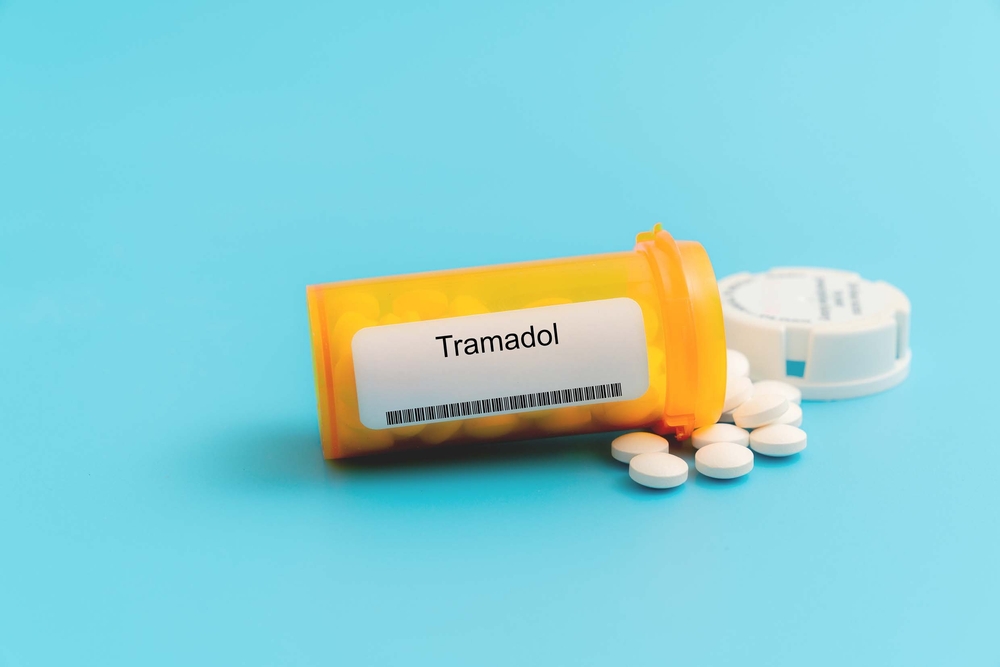Last Updated:
May 29th, 2025
Reports from the British Journal of General Practice on opioid use in the UK show that prescribed painkillers such as tramadol are on the rise. Perhaps you or a loved one has been given a painkiller by a medical professional and are wondering if it’s safe to drink alcohol on a night out.
Yet, there are severe risks when the two combine, which most people are unaware of.

What is tramadol?
Tramadol is a strong opioid painkiller used to treat moderate to severe pain, often after a person has a serious operation or injury. Tramadol can go under brand names, including Maxitram, Marol, Zydol, Zamadol, Tramulief and Tramquel.
Extended-release tablets are used in medical settings to treat chronic pain when opioid treatment is needed. In the UK, doctors can also prescribe tramadol for a person suffering from prolonged pain if weaker painkillers are no longer enough.
Tramadol belongs to the group of medicines called “opioid analgesics,” meaning it interferes with pain messages between the body and brain, operating through your central nervous system. As a CNS depressant, it attaches to opioid receptors, generating pleasing effects that can relieve severe pain.
How do alcohol and tramadol interact in the body?
While tramadol may be a less common part of most people’s lives, the majority of people have experienced alcohol’s effects without fully understanding the mechanisms behind it.
Alcohol in its drinking form, ethanol, is the liquid distilled from grains, fruits, or other sugars. Alcohol works by interacting with inhibitory neurotransmitters in the brain called GABA (Gamma-Aminobutyric Acid). By stimulating these GABA receptors, alcohol dampens or “depresses” activity in the brain. This is why many people can feel reduced anxiety when drinking. Yet these depressant effects of alcohol on the central nervous system can dangerously interact with tramadol.
When both alcohol and tramadol are in the body, there are greater dangers to your central nervous system, as well as the parts of your brain that control breathing, heart rate and motor coordination. The interaction of each drug enhances the sedative effects of the other, raising the risk of serious complications.
Below are common effects when combined, as well as more serious effects when larger doses are taken:
Common side effects when mixing alcohol and tramadol
Some of the most commonly felt effects when combining tramadol and alcohol can include:
- Severe drowsiness and dizziness
- Difficulty concentrating or confusion
- Stomach upset, nausea and vomiting
- Impaired coordination and slowed reflexes
While these may be relatively mild if a small amount of alcohol and tramadol is consumed, the effects can quickly multiply when the amount of just one substance is increased. The compound effect of even a small mixture can become dangerous as day-to-day activities like driving or using machinery become significantly riskier.
Severe side effects stemming from heavier usage
The more tramadol and alcohol are consumed together, the greater the risk of more severe health issues. Some of these include:
- Respiratory depression: Both substances suppress parts of the brain responsible for breathing, so when taken together, breathing can slow or stop entirely.
- Loss of consciousness: Blackouts or coma-like states can happen when the two substances combine due to overwhelming NCS suppression.
- Seizures: Research highlights how opioids like tramadol can lower the seizure threshold, while alcohol can increase the likelihood of experiencing one. This is an especially dangerous interaction, especially if a person binge drinks large amounts.
- Serotonin toxicity: Alcohol, as well as most opioid painkillers, increases serotonin levels in the body. Serotonin is a chemical messenger often used in medicines that treat mental illnesses like anxiety and depression. Having too much serotonin in your body can cause a condition called “serotonin syndrome,” which can be life-threatening.
Long-term effects of tramadol and alcohol use
Continued use of tramadol and alcohol in combination can cause lasting damage to both the body and mind. Long-term risks of mixing include:
- Liver and kidney strain: Both your liver and kidneys work to filter these substances, so prolonged stress can lead to chronic liver or kidney disease.
- Cognitive impairments: Prolonged dual use can have negative consequences on the brain, including memory loss, reduced attention span and emotional blunting from a sense of “detachment.”
- Mental health deterioration: Mental health conditions like anxiety and depression are more common in people misusing both substances. Suicidal ideation may increase as mental health deteriorates.
- Risk of addiction: Frequently taking both drugs together increases the likelihood of addiction. A painkiller or alcohol addiction can quickly take hold and lay the foundations for a dangerous path.
How long after taking tramadol can I drink alcohol?
After taking tramadol, it is always safest to wait until it is completely out of your system before you have a drink. The half-life of tramadol is generally between 6 to 8 hours, meaning that after this time, the concentration of tramadol in your blood is reduced by half.
Researchers believe that most drugs take 4 to 5 half-lives before they are effectively eliminated from your body. Therefore, tramadol should be out of your system between 30 and 40 hours. It is important to remember, however, that there are short-acting and long-acting forms of tramadol, so a larger window should be considered to ensure the substance has been cleared from the body.
Can you overdose when taking tramadol and alcohol together?
Simply put, yes, you can overdose when taking tramadol and alcohol together. Both substances are CNS depressants, so some of the biggest risks are placed on your breathing and the beating of your heart. As the effects of both substances unfold, a person can stop breathing. If your breathing rate becomes too slow or stops, you can enter a coma state. In an overdose, the brain may be dangerously deprived of oxygen. Research shows that after just four minutes without oxygen, a person likely suffers irreversible brain damage, with any longer being fatal.
How can I recognise and respond to a tramadol and alcohol overdose?
It is possible to overdose on tramadol on its own, but if it’s taken in conjunction with large amounts of alcohol, the risk increases significantly. If you are worried that you’re witnessing someone entering an overdose, first look for these signs:
- Loss of consciousness
- Seizure
- Slowed or shallowed breathing
- Pale or blue skin, especially on fingertips or lips
In the UK, contacting emergency help by dialling 999 is imperative. If they are not yet unconscious, try to help them remain conscious and awake. If the overdose starts to worsen, you may need to check their airways and provide “rescue breathing.”
Stay with them and wait for the medical team to arrive. If their temperature drops, wrap them in warmer clothing to maintain enough heat. When responders reach you, you can help by telling them the person’s age, how much they took and when they took the substances if known.
Witnessing an overdose in another person or experiencing one yourself can be a frightening ordeal. The best way to help avoid an overdose is to prevent mixing the substances altogether. This is where professional treatment may become imperative for escaping substance abuse.
Where can I find help for an addiction?
Mixing tramadol and alcohol is extremely dangerous and can lead to irreversible damage, overdose, or even death. If you or a loved one is struggling to stop or manage your use of either substance, getting help may be the turning point you need before things get worse.
At UKAT Recovery Lighthouse, we offer expert, compassionate care tailored to drug addiction. Our detox programmes manage withdrawal safely while evidence-based therapies and long-term aftercare help you stay on track.
A better life is just one call away—reach out today and take that first step.


